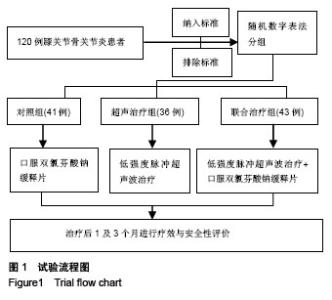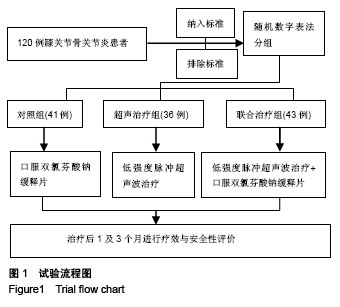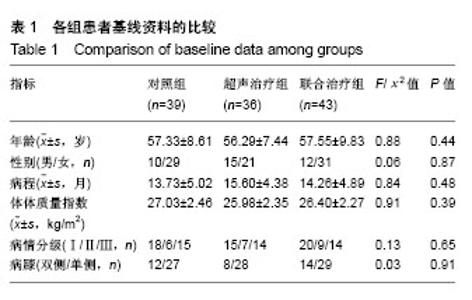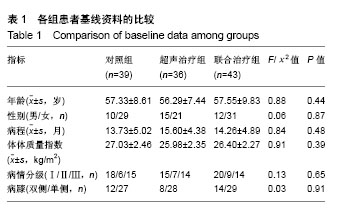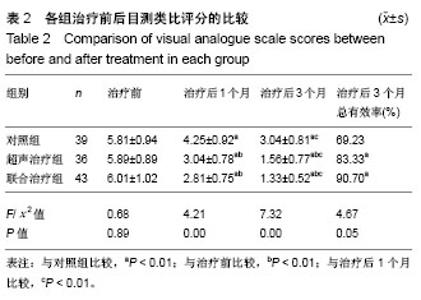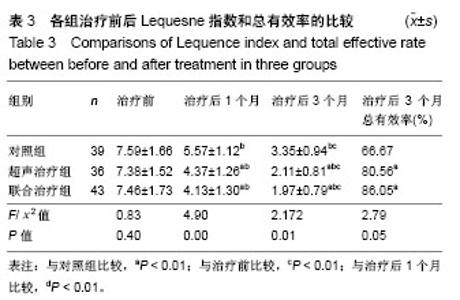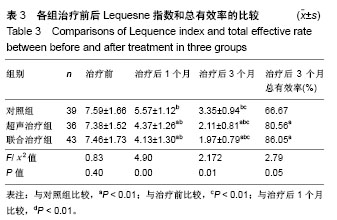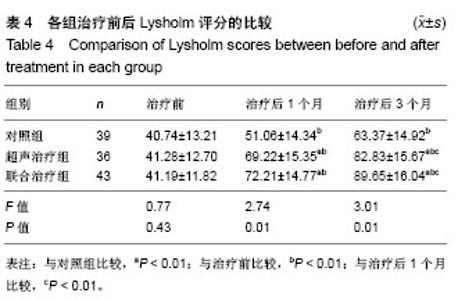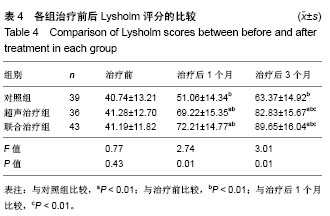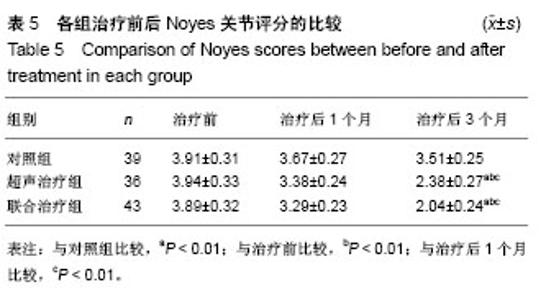| [1] 武佳奇,张庆胜,靳宪辉.不同术式治疗内侧性疼痛膝关节骨关节炎的临床疗效比较[J].山西医药杂志,2017,46(21):2594-2597.[2] 宋莉,董英伟,闫全章,等.不同浓度辣椒辣素对小鼠慢性膝关节炎疼痛模型的治疗效果分析[J].现代生物医学进展, 2017,17(27): 5223-5226.[3] 谢东兴,王伊伦,李辉,等.神经肌肉电刺激治疗膝骨关节炎疼痛的Meta分析[J].中国组织工程研究,2014,18(38):6228-6232. [4] ?urovi? A, Sovilj S, ?oki? I, et al. Pastoral care and religious support as a part of treatment of religious patient with the severe form of osteoarthritis. Vojnosanit Pregl. 2017;74(1):69-77.[5] Shin YA, Suk MH, Jang HS, et al. Short-term effects of Theracurmin dose and exercise type on pain, walking ability, and muscle function in patients with knee osteoarthritis.J Exerc Rehabil.2017;13(6):684-692.[6] Silvinato A, Bernardo WM. Inflammatory arthritis or osteoarthritis of the knee-Efficacy of intra-joint infiltration of methylprednisolone acetate versus triamcinolone acetonide or triamcinolone hexacetonide. Rev Assoc Med Bras. 2017;63(10):827-836.[7] Owens C, Conaghan PG. Improving joint pain and function in osteoarthritis.Practitioner.2016;260(1799):17-20.[8] Baker KG, Robertson VJ, Duck FA. A review of therapeutic ultrasound: biophysical effects. Phys Ther.2001;81(7):1351-1358.[9] 张璟,阎作勤.超声在骨关节炎诊疗中应用的新进展[J].中华关节外科杂志,2015,9(4):520-523.[10] 贾小林,陈文直,司海鹏,等.超声对兔关节软骨损伤的修复作用[J].中华创伤杂志,2004,20(2):97-99.[11] 周崑,周伟,贾小林,等.超声对实验性早期兔膝关节骨关节炎的作用[J].重庆医科大学学报,2008, 33(1):6-8.[12] Gurkan I, Ranganathan A, Yang X, et al. Modification of osteoarthritis in the guinea pig with pulsed low-intensity ultrasound treatment.Osteoarthritis Cartilage.2010;18(5):724-733.[13] 李梅,张峰霖.低频脉冲超声治疗膝关节骨关节炎疗效分析[J].中国现代药物应用,2014,8(18):38-39. [14] 杨烨,曾超,邓桢翰,等.超声疗法治疗膝关节骨关节炎疼痛的荟萃分析[J].中国组织工程研究,2014,18(33):5396-5401.[15] 张维林,刘萍,杜春萍.法斯通代替耦合剂对骨关节炎患者行超声治疗的作用[J].现代医学,2015,43(6):789-790.[16] Bossmann T, Brauner T, Horstmann T. Differences in pain intensity in anti- and pro-nociceptive pain profile subgroups in patients with knee osteoarthritis. Pain Manag.2018;8(1):27-36.[17] 蔡琛,石俊英,杨宁,等.综合康复治疗膝骨关节炎软骨病变的磁共振成像研究[J].中国康复医学杂志,2016,31(12):1363-1366.[18] Andew D, Russell J, Kenneth R. Objectively assessed physical activity and weight status in Maltese 11-12 year-olds. Eur J Sport Sci.2014;14 (1):257-266.[19] 韩宏德,蒋家正,张恒林,等.脉冲射频术和单纯药物治疗对膝骨性关节炎疼痛及炎症指数的影响与安全性分析[J].中国临床研究,2017, 30(5):658-660.[20] 董明卫.高频超声在膝关节骨关节炎中的应用[J].实用医学影像杂志, 2017,18(4):320-322.[21] 杨颖.低强度聚焦超声治疗骨关节炎研究进展[J]. 现代医药卫生, 2013,29(2):224-226.[22] Bhandari M, Bannuru RR, Babins EM, et al. Intra-articular hyaluronic acid in the treatment of knee osteoarthritis: a Canadian evidence-based perspective. Ther Adv Musculoskelet Dis. 2017;9(9): 231-246.[23] Wong RA, Schumann B, Townsend R, et al. A survey of therapeutic ultrasound use by physical therapists who are orthopaedic certified specialists.Phys Ther. 2007;87(8):986-994.[24] Yang PF, Li D, Zhang SM, et al. Efficacy of ultrasound in the treatment of osteoarthritis of the knee. Orthop Surg.2011;3(3): 181-187.[25] 杨鹏飞,李东,张世模,等.超声治疗膝关节骨关节炎的疗效分析[J].临床超声医学杂志,2011,13(5):296-300.[26] 唐进,黄良库,李东,等.低频脉冲超声治疗膝关节骨关节炎疗效分析[J].第三军医大学学报,2010,32(23):2562-2564.[27] Tascioglu F, Kuzgun S, Armagan O, et al. Short-term effectiveness ofultrasound therapy in knee osteoarthritis. J Int Med Res.2010;38(4): 1233-1242.[28] 孙利昆,张迅杰,刘志燕,等.11 种干预措施治疗膝骨关节炎的疗效评价[J].天津中医药,2018,35(2):116-121.[29] Piuzzi NS, Khlopas A, Newman JM, et al. Bone marrow cellular therapies: novel therapy for knee osteoarthritis.J Knee Surg.2018; 31(1):22-26.[30] Liow Y, Wang W, Loh VW. Outpatient management of knee osteoarthritis. Singapore Med J. 2017;58(10):580-584.[31] 王小红,王洪,杨述华,等.低强度脉冲式超声对实验性兔骨关节炎软骨损伤修复的影响[J].国际骨科学杂志,2009,30(3):191-193.[32] Cook SD, Salkeld SL, Popich-Patron LS, et al. Improved cartilage repair after treatment with low-intensity pulsed ultrasound. Clin Orthop Relat Res.2001;23(391 Suppl):S231-243.[33] 唐进,黄良库,彭李华,等.低频脉冲超声干预膝关节骨关节炎模型兔关节软骨及滑膜水通道蛋白3的表达[J].中国组织工程研究与临床康复,2011,15(11):1941-1944.[34] Riccardo C, Fabio C, Pietro R. Knee Osteoarthritis after Reconstruction of Isolated Anterior Cruciate Ligament Injuries: A Systematic Literature Review. Joints. 2017;5(1):39-43.[35] 成吉华,赵丹,郭杨,等.低强度脉冲超声治疗骨关节炎的应用进展[J].临床超声医学杂志,2014,16(7):475-477.[36] Kocaoglu B, Cabukoglu C, Ozeras N, et al. The effect of therapeutic ultrasound on metallic implants:a study in rats. Arch Phys Med Rehabil.2011;92(11):1858-1862. |
